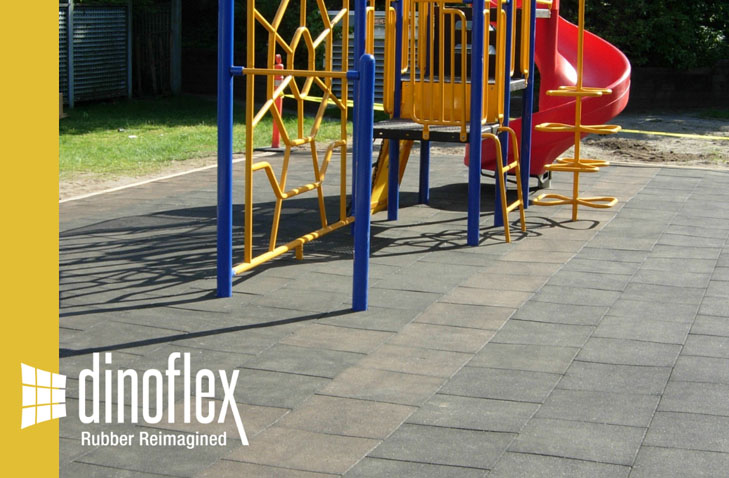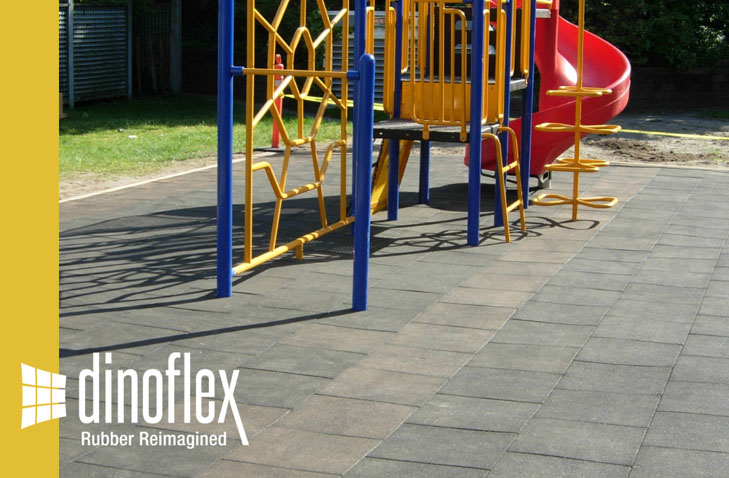From preschool to high school to university, many factors play into creating a positive educational experience. Sustainable construction products such as Dinoflex recycled rubber flooring can help schools create healthy spaces for students.

Rubber floors are easy to install, stain-resistant, and provide a safe surface on which to walk, run, and play. Designers, facility managers, principals, and building officials want to create the ideal environment for students who walk the halls and inhabit the classrooms of their institutions. For affordable flooring choices that come in a variety of colours, more schools are choosing efficient, safe, and long-lasting recycled rubber flooring.
Rubber flooring made from recycled tires offers measurable advantages to the schools that choose them. With hundreds of students clamoring in the hallways every time the bell rings, sound pollution becomes a real issue. Fortunately, recycled rubber flooring (available in square or interlocking mats) absorbs sound to reduce indoor noise pollution.
Recycled rubber flooring also requires less maintenance and is easier to clean than many other options. Keep reading to find out where you can use slip-resistant recycled rubber flooring in your school.
Where Should You Use Recycled Rubber Flooring in A School?
You can use recycled rubber flooring in spaces where safety, cleanliness, and durability are a priority. We recommend starting with high-traffic areas such as hallways and entrances. When you need to provide a soft surface to prevent injuries, choose recycled rubber floors for exercise areas such as gymnasiums and weight rooms.
Here are a few examples of spaces where our clients use recycled rubber flooring in place of carpet or hardwood materials:
- classrooms
- gymnasiums
- offices
- cafeterias
- laboratories
- hallways
The resilience of recycled rubber flooring often exceeds the diverse range of demands required for construction materials in schools and universities. Versatile recycled rubber flooring can help you achieve a safe, fun environment without going over budget.
What Are Some Creative Ideas for Rubber Flooring in Schools?
The huge colour selection available with Dinoflex rubber flooring allows your designers to incorporate school colours into entryways, hallways, and other areas that receive heavy foot traffic.
Here are some other ideas for schools looking for flooring options that enhance teaching and learning experiences:
- Create a bright classroom for young learners. Colour is a primary design element that can impact student morale, concentration, and performance. Choosing contrasting colours can enhance visual appeal for students who spend most of their day in a classroom. Further, pops of colour can help students mentally prepare for activities at different learning stations.
- Design your own logos and patterns. Dinoflex custom floor designs and logos provide the perfect addition to any areas where you want to show some school spirit or individuality. You can even design your own shades to match your school colours.
- Use multi-coloured granules to enliven high-traffic areas. Dinoflex recycled rubber flooring has multi-coloured granules that add interest and help keep your flooring from looking dull and worn.
- Install recycled rubber flooring to help teachers stay comfortable. Even if they wear comfortable shoes, teachers can develop fatigue from being on their feet all day. Rubber flooring provides a cushion that makes standing at the whiteboard more comfortable.
- Quieten high-traffic hallways with attractive recycled rubber flooring. Rubber flooring provides traction underfoot to keep walkways safe. This recycled material also absorbs sounds, so your students won’t sound like a herd of elephants passing through on their way to class!
- Reduce floor maintenance in cafeterias with stain-resistant recycled rubber tiles. Non-porous rubber floors don’t absorb liquids, which can reduce stains from spilled beverages and food items. This flexible flooring material also cleans up quickly, saving time and effort for your janitorial staff.
- Design safer student labs. Science classrooms are prone to messes, and advanced classes may use corrosive materials for experiments. Recycled rubber tiles are more durable than hardwood or vinyl flooring.
These tiles resist fungi, microbes, and bacteria, making them a natural choice in many areas of your preschool, elementary school, high school, or university.
Fall Height – What Is It and Why Is It Important?
The maximum height for playground equipment is typically 6 feet. So-called fall zones are the areas around swings, climbing equipment, and other playground features that encourage kids to jump, climb, and develop their motor skills. To give kids the freedom to do that, you need flooring that protects them from falls.
What is Fall Height?
According to the International Association for Testing and Materials, fall height represents the vertical distance between the top of a play surface and the protective flooring. ASTM F1292 sets standards for shock absorbency and impact mitigation to keep play areas safe.
Although it varies, depending on which standards you follow, maximum fall height is typically 6 feet (2 meters). Here are some examples of how to measure fall height on various equipment:
- Climbing equipment – highest foot support on the climber
- Upper body equipment – highest point on the equipment
- Swing sets – pivot point (highest point swing can reach)
- Seesaws – seat height
- Spring rockers – seat height
Recycled rubber provides a firm surface for running and walking. It also provides cushioning when children trip and fall. Dinoflex outdoor mats and tiles can help prevent injury and cushion falls so children can concentrate on creative play.
What’s the best protective surface for playgrounds? Recycled Rubber flooring is more resilient than outdoor carpet or hardwoods and can protect children from head injuries on the playground.
Is It Important to Have HPD or EPD FloorScore Certification?
Yes, facility managers and school designers should look for FloorScore certification when choosing flooring materials for their schools. These important measures recognize sustainable, environmentally friendly construction materials that don’t harm indoor air quality.
FloorScore is arguably the most recognized certification for indoor air quality (IAQ) when it comes to evaluating adhesives, flooring materials and underlayment, if used. Attaining a positive floor score indicates low VOC emissions. So, FloorScore approved materials help keep volatile organic compounds out of kids’ lungs and airways.
There are two other designations that show the health and environmental impact of flooring materials, as follows:
- The Health Product Declaration (HPD) categorizes the health impact of various building materials.
- Environmental Product Declaration (EPD) is a voluntary measure taken by a third-party organization. An EPD summarizes the findings of various tests to show whether materials are safe for students and the environment.
Is Dinoflex Rubber Flooring FloorScore Certified?
Dinoflex recycled rubber flooring has achieved HPD, EPD, and FloorScore certifications. Even the EPDM-coloured granules that add colours and variety to our rubber tiles and other flooring materials have the lowest VOCs in the industry.
Is Installing Recycled Rubber Flooring Easy?
Dinoflex produces interlocking and straight-edged recycled rubber mats and tiles. The shape and size of the tiles make them super easy to layout, orient and install.
This video shows just how easy it is to install Dinoflex recycled rubber flooring on concrete. Remember to lay out the tiles and let them sit for 48 hours prior to installation. This allows the tiles to acclimate to the temperature and allow environmental conditions.
Can I Install Rubber Flooring on Different Surfaces?
Installers often place rubber tiles over existing flooring materials such as concrete, ceramic tiles, and hardwood. However, we don’t recommend installing recycled rubber flooring over carpet.
- You can install rubber flooring over ceramic tiles. Following heavy use and age, ceramic tiles tend to become brittle. So, the tiles can break or crack over time and cause the rubber flooring to shift. Choosing the proper subflooring can prevent unnecessary damage.
- Hardwood flooring gives any space an elegant and attractive appearance. Yet, scarred, and warped hardwood floors can make your facility appear outdated and may present safety issues. Installing recycled rubber floors over hardwood restores the beauty of your flooring without incurring additional expenses to rip up the original floor. By placing protective paper on top of the hardwood prior to installing your new floor, you can protect the underlying high-quality hardwood.
- Installing rubber tiles over carpeting can create more problems than it solves. It’s simply not a good idea.
How Do You Clean Your Recycled Rubber Floors?
Dinoflex recycled rubber flooring materials arrive with detailed instructions on ideal maintenance and cleaning practices. Following these instructions can result in long-lasting rubber floors that maintain their original beauty.
Here are a few tips on mopping and cleaning techniques that can preserve your school’s recycled rubber flooring:
- After sweeping, damp mop with a microfiber mop and avoid using string mops.
- Use DinoClean or another neutral PH cleaner mixed with water to keep your recycledrubber floors dirt-free.
- Avoid products that have acids and solvents that will cause the recycled rubber flooring to deteriorate.
- Apply DinoClean to protect the surface after cleaning. However, avoid sealants and waxes that can harm your recycled rubber flooring.
Frequent cleaning can prevent dirt and grime from building up on rubber tiles and mats.
Does Recycled Rubber Flooring Absorb Sound?
Hundreds of students changing classrooms, filing in and out of assemblies, and going to lunch, create an awful ruckus. High levels of sound can have two harmful impacts on the learning environment:
- Sound can travel from room to room and between floors, potentially disturbing students taking tests or teachers conducting classes.
- Sound pollution can negatively impact acoustics, making it hard to hear music or speech in the classroom.
Rubber flooring absorbs sound, reducing the disruption caused by noisy footfalls and talking. Acoustic flooring protects upper floors and lower floors from noise pollution and can keep noise from traveling from room to room when paired with other sound-absorbing building materials.
How Does a Colourful Floor Benefit a Child’s Education?
Children need to feel comfortable in order to learn effectively in the school environment. Energetic colours can inspire interaction and activity and encourage children to socialize. Dinoflex recycled rubber flooring comes in a variety of colours designed to soothe, invigorate, or inspire children, depending on the application.
Whether you’re adding recycled rubber flooring to an early learning center or high school hallway, oranges, yellows, and reds create exciting patterns that complement a positive school culture. Cool blues and aquamarines create a soothing environment in math or science classrooms.
Dinoflex gives educators and stakeholders the tools they need to choose flooring colours conducive to an effective learning environment.
Here are some tips to help you use Dinoflex’s helpful colour tools:
- Choose from dozens of EPDM colours and request a swatch with a single click.
- Engineer your own colours for indoor or outdoor applications.
- Choose indoor or outdoor rubber flooring.
- Choose your base colours.
- “Mix” the base colours by percentage to create an on-screen swatch.
- Look through our case studies for inspiration on hues adopted by other customers.
How Durable Is Recycled Rubber Flooring Actually?
Recycled rubber flooring is resilient and can last up to 20 years with proper maintenance. Rubber tiles typically last longer than rolls of flooring. That’s because you can remove individual tiles and replace them quickly. This can help reduce waste and installation fees and keep your floors in excellent shape.
Recycled rubber flooring withstands heavy foot traffic and repels moisture, making it ideal for cafeterias, hallways, and other areas where students carry beverages and food items. The natural cushioning provided by rubber flooring makes it comfortable to walk on and can help prevent injuries. The same quality protects rubber flooring from impacts that can damage harder materials such as ceramic tiles or hardwood.
At Dinoflex, we can help you obtain cost-effective, sustainable, and long-lasting rubber flooring for your educational facility. Contact us online for a free consultation on school recycled rubber flooring. You can also reach us directly by calling (877) 713-1899.


